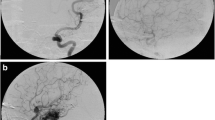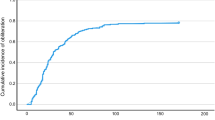Abstract
Background
Few studies have evaluated the relationship between brain arteriovenous malformations (bAVMs) angioarchitecture and the response to Gamma Knife Stereotactic Radiosurgery (GKSR).
Methods
A prospectively enrolled single-center cohort of patients with bAVMs treated by GKSR has been studied to define independent predictors of obliteration with particular attention to angioarchitectural variables. Only patients older than 18 years old (y.o.), who underwent baseline digital subtraction angiography (DSA) and clinico-radiological follow-up of at least 36 months, were included in the study.
Results
Data of 191 patients were evaluated. After a mean follow-up of 80 months (range 37–173), total obliteration rate after first GKSR treatment was 66%. Mean dose higher than 22 Gy (P = .019, OR = 2.39, 95% CI 1.15–4.97) and flow rate dichotomized into high vs non-high (P < .001, OR = 0.23, 95% CI 0.11–0.51) resulted to be independent predictors of obliteration. Flow-surrogate angioarchitectural features did not emerge as independent outcome predictors.
Conclusions
Flow rate seems to be associated in predicting outcome after GKSR conferring high-flow AVM a lower occlusion rate. Its role should be considered when planning radiosurgical treatment of bAVM, and it could be added to other parameters used in GKRS outcome predicting scales.


Similar content being viewed by others
Abbreviations
- bAVMs:
-
Brain arteriovenous malformations
- GKSR:
-
Gamma Knife Stereotactic Radiosurgery
- DSA:
-
Digital subtraction angiography
- OR:
-
Odds ratio
- CI:
-
Confidence interval
- MRI:
-
Magnetic resonance imaging
- SRS:
-
Stereotactic radiosurgery
- AED :
-
Antiepileptic drug
- ROC:
-
Receiver operating characteristic
- AUC:
-
Area under ROC curve
References
Abla AA, Rutledge WC, Seymour ZA et al (2015) A treatment paradigm for high-grade brain arteriovenous malformations: volume-staged radiosurgical downgrading followed by microsurgical resection. J Neurosurg 122(2):419–432
Alexander MD, Cooke DL, Nelson J, Guo DE, Dowd CF, Higashida RT, Halbach VV, Lawton MT, Kim H, Hetts SW (2015) Association between venous angioarchitectural features of sporadic brain arteriovenous malformations and intracranial hemorrhage. AJNR Am J Neuroradiol 36(5):949–952
Bose R, Agrawal D, Singh M, Kale SS, Gopishankar N, Bisht RK, Sharma BS (2015) Draining vein shielding in intracranial arteriovenous malformations during gamma-knife: a new way of preventing post gamma-knife edema and hemorrhage. Neurosurgery 76(5):623–632
Chang JH, Chang JW, Park YG, Chung SS (2000) Factors related to complete occlusion of arteriovenous malformations after gamma knife radiosurgery. J Neurosurg 93(Suppl 3):96–101
Cuong NN, Luu VD, Tuan TA, Linh LT, Hung KD, Ngoc VTN, Sharma K, Pham VH, Chu DT (2018) Conventional digital subtractional vs non-invasive MR angiography in the assessment of brain arteriovenous malformation. Clin Neurol Neurosurg. https://doi.org/10.1016/j.clineuro.2018.03.022
Da Costa L, Wallace MC, Ter Brugge KT, O’ Kelly C, Willinsky RA, Tymianski M (2009) The natural history and predictive features of hemorrhage from brain arteriovenous malformations. Stroke 40(1):100–105
Ding D, Yen CP, Starke RM, Xu Z, Sun X, Sheehan JP (2014) Outcomes following single-session radiosurgery for high-grade intracranial arteriovenous malformations. Br J Neurosurg 28(5):666–674
Derdeyn CP, Zipfel GJ, Albuquerque FC, Cooke DL, Feldmann E, Sheehan JP, Torner JC (2017) Management of brain arteriovenous malformations: a scientific statement for healthcare professionals from the American Heart Association/American Stroke Association. Stroke 48(8):e200–e224
Franzin A, Panni P, Spatola G, Vecchio AD, Gallotti AL, Gigliotti CR, Cavalli A, Donofrio CA, Mortini P (2016) Results of volume-staged fractionated gamma knife radiosurgery for large complex arteriovenous malformations: obliteration rates and clinical outcomes of an evolving treatment paradigm. J Neurosurg 125(Suppl 1):104–113
Fukuoka S, Takanashi M, Seo Y, Suematsu K, Nakamura JI (1998) Radiosurgery for arteriovenous malformations with gamma-knife: a multivariate analysis of factors influencing the complete obliteration rate. J Clin Neurosci 5(SUPPL.1):68–71
Haw CS, terBrugge K, Willinsky R, Tomlinson G (2006) Complications of embolization of arteriovenous malformations of the brain. J Neurosurg 104(2):226–232
Kano H, Kondziolka D, Flickinger JC, Park K-J, Parry PV, Yang H, Sirin S, Niranjan A, Novotny J, Lunsford LD (2012) Stereotactic radiosurgery for arteriovenous malformations, part 6: multistaged volumetric management of large arteriovenous malformations. J Neurosurg 116(1):54–65
Kim H, Salman RA-S, McCulloch CE, Stapf C, Young WL, Coinvestigators M (2014) Untreated brain arteriovenous malformation. Neurology 83(7):590–597
Kwon Y, Jeon SR, Kim JH, Lee JK, Ra DS, Lee DJ, Kwun BD (2000) Analysis of the causes of treatment failure in gamma knife radiosurgery for intracranial arteriovenous malformations. J Neurosurg 93(Suppl 3):104–106
Lang S, Gölitz P, Struffert T, Rösch J, Rössler K, Kowarschik M, Strother C, Doerfler A (2017 Jun) 4D DSA for dynamic visualization of cerebral vasculature: a single-center experience in 26 cases. AJNR Am J Neuroradiol 38(6):1169–1176. https://doi.org/10.3174/ajnr.A5161
MacDonald ME, Dolati P, Mitha AP, Wong JH, Frayne R (2016) Flow and pressure measurements in aneurysms and arteriovenous malformations with phase contrast MR imaging. Magn Reson Imaging. https://doi.org/10.1016/j.mri.2016.07.007
Meder JF, Oppenheim C, Blustajn J, Nataf F, Merienne L, Lefkoupolos D, Laurent A, Merland JJ, Schlienger M, Fredy D (1997) Cerebral arteriovenous malformations: the value of radiologic parameters in predicting response to radiosurgery. Am J Neuroradiol 18(8):1473–1483
Monaco RG, Alvarez H, Goulao A, Pruvost P, Lasjaunias P (1990) Posterior fossa arteriovenous malformations—angioarchitecture in relation to their hemorrhagic episodes. Neuroradiology 31(6):471–475
Nakstad PH, Nornes H (1994) Superselective angiography, embolisation and surgery in treatment of arteriovenous malformations of the brain. Neuroradiology 36(5):410–413
Ognard J, Magro E, Caroff J, Ben Salem D, Andouard S, Nonent M, Gentric JC (2018 May) A new time-resolved 3D angiographic technique (4D DSA): description, and assessment of its reliability in Spetzler-Martin grading of cerebral arteriovenous malformations. Neuroradiol. 45(3):177–185. https://doi.org/10.1016/j.neurad.2017.11.004
Paúl L, Casasco A, Kusak ME, Martínez N, Rey G, Martínez R (2014) Results for a series of 697 arteriovenous malformations treated by gamma knife. Neurosurgery 75(5):568–583
Pollock BE, Flickinger JC, Lunsford LD, Maitz A, Kondziolka D (1998) Factors associated with successful arteriovenous malformation radiosurgery. Neurosurgery 42(6):1239–1247
Pollock BE, Kline RW, Stafford SL, Foote RL, Schomberg PJ (2000) The rationale and technique of staged-volume arteriovenous malformation radiosurgery. Int J Radiat Oncol Biol Phys 48(3):817–824
Schuster L, Schenk E, Giesel F, Hauser T, Gerigk L, Zabel-Du-Bois A, Essig M (2011) Changes in AVM angio-architecture and hemodynamics after stereotactic radiosurgery assessed by dynamic MRA and phase contrast flow assessments: a prospective follow-up study. Eur Radiol. https://doi.org/10.1007/s00330-010-2031-0
Spetzler RF, Martin NA (1986) A proposed grading system for arteriovenous malformations. J Neurosurg 65(4):476–483
Starke RM, Yen C-P, Ding D, Sheehan JP (2013) A practical grading scale for predicting outcome after radiosurgery for arteriovenous malformations: analysis of 1012 treated patients. J Neurosurg 119(4):981–987
Statham P, Macpherson P, Johnston R, Forster DM, Hume Adams J, Todd NV (1990) Cerebral radiation necrosis complicating stereotactic radiosurgery for arteriovenous malformation. J Neurol Neurosurg Psychiatry 53(6):476–479
Taeshineetanakul P, Krings T, Geibprasert S, Menezes R, Agid R, Terbrugge KG, Schwartz ML (2012) Angioarchitecture determines obliteration rate after radiosurgery in brain arteriovenous malformations. Neurosurgery 71(6):1071–1078
Taylor CL, Dutton K, Rappard G, Pride GL, Replogle R, Purdy PD, White J, Giller C, Kopitnik TA, Samson DS (2004) Complications of preoperative embolization of cerebral arteriovenous malformations. J Neurosurg 100(5):810–812
Valavanis A, Yaşargil MG (1998) The endovascular treatment of brain arteriovenous malformations. Adv Tech Stand Neurosurg 24:131–214
Yen CP, Schlesinger D, Sheehan JP (2012) Natural history of cerebral arteriovenous malformations and the risk of hemorrhage after radiosurgery. Prog Neurol Surg. 27:5-21. https://doi.org/10.1159/000341616.
Yen CP, Sheehan JP, Schwyzer L, Schlesinger D (2011) Hemorrhage risk of cerebral arteriovenous malformations before and during the latency period after gamma knife radiosurgery. Stroke 42(6):1691–1696
Yuki I, Kim RH, Duckwiler G, Jahan R, Tateshima S, Gonzalez N, Gorgulho A, Diaz JL, De Salles AA, Viñuela F (2010) Treatment of brain arteriovenous malformations with high-flow arteriovenous fistulas: risk and complications associated with endovascular embolization in multimodality treatment: clinical article. J Neurosurg. https://doi.org/10.3171/2009.9.JNS081588
Zipfel GJ, Bradshaw P, Bova FJ, Friedman WA (2004) Do the morphological characteristics of arteriovenous malformations affect the results of radiosurgery? J Neurosurg 101(3):393–401
Author information
Authors and Affiliations
Corresponding author
Ethics declarations
Conflict of interest
All authors certify that they have no affiliations with or involvement in any organization or entity with any financial interest (such as honoraria; educational grants; participation in speakers’ bureaus; membership, employment, consultancies, stock ownership, or other equity interest; and expert testimony or patent-licensing arrangements), or non-financial interest (such as personal or professional relationships, affiliations, knowledge, or beliefs) in the subject matter or materials discussed in this manuscript.
Ethical approval
All procedures performed in studies involving human participants were in accordance with the ethical standards of the institutional and/or national research committee and with the 1964 Helsinki declaration and its later amendments or comparable ethical standards. For this type of study, formal consent is not required.
Informed consent
Informed consent was obtained from all individual participants included in the study.
Additional information
Publisher’s note
Springer Nature remains neutral with regard to jurisdictional claims in published maps and institutional affiliations.
This article is part of the Topical Collection on Vascular Neurosurgery - Arteriovenous malformation
Electronic supplementary material
ESM 1
(DOCX 24 kb).
Rights and permissions
About this article
Cite this article
Panni, P., Gallotti, A.L., Gigliotti, C.R. et al. Impact of flow and angioarchitecture on brain arteriovenous malformation outcome after gamma knife radiosurgery: the role of hemodynamics and morphology in obliteration. Acta Neurochir 162, 1749–1757 (2020). https://doi.org/10.1007/s00701-020-04351-4
Received:
Accepted:
Published:
Issue Date:
DOI: https://doi.org/10.1007/s00701-020-04351-4




